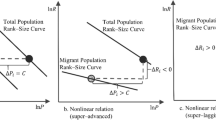Abstract
The study was in order to know the urban agglomerations’ comprehensive capacity, driving forces and the spatial pattern of gravity; Taking cases of 4 urban agglomerations in Sichuan, an evaluation system was constructed in 3 dimensions: sociology, ecology and economics. The comprehensive carrying capacity level and driving forces were evaluated by entropy weight-TOPSIS, and revised gravity model was used to analyze the interaction forces and industry division; The results showed that the majority of the cities’ comprehensive capacity increased and it still had a lot of room for improvement; industrial structure, population urbanization, urban infrastructure construction became the key drivers of the urban agglomerations development; the spatial pattern and industry division were not rational, diffusion effects of core cities were not marked; Some measures should be taken to achieve healthy urbanization of Sichuan, such as optimizing the structure of urban agglomeration, congregating development of the provincial capital city Chengdu, multi-point supporting of the secondary core cities and guiding of government.
Access this chapter
Tax calculation will be finalised at checkout
Purchases are for personal use only
Similar content being viewed by others
References
Bruno, G., Genovese, A.: A spatial interaction model for the representation of the mobility of university students on the italian territory. Netw. Spat. Econ. 12(1), 41–57 (2012)
Chen, Y., Luo, J.: A review of the research on coordinated development of urban agglomerations. Urban Probl. 1, 26–31 (2013)
Cheng, G., Zhang, P.: Study on evaluation of urban comprehensive bearing capacity of northern slope economic belt of tianshan mountain (in Chinses). Chin. Agric. Sci. Bull. 17, 48–52 (2007)
Cheng, G., Shen, L., Long, W.: Comparative research on comprehensive carrying capacity of urban agglomerations along silk road economic belt in northwest China (in chinses). Econ. Geogr. 35(8), 98–103 (2015)
Deng, R.: Carbon emission reduction performance evaluation of changzhu-zhuzhou-xiangtan two-oriented society pilot project—an empirical study based on the dual difference method (in chinses). Soft Sci. 30(9), 51–55 (2016)
Fang, C., Yu, D.: Urban agglomeration: an evolving concept of an emerging phenomenon. Landsc. Urban Plan. 162, 126–136 (2017)
Feng, T., Zhang, H., Hu, J., Xia, X.: Dynamics of green productivity growth for major chinese urban agglomerations. Appl. Energy 196, 170–179 (2016)
Kang, Z., Li, K., Qu, J.: The path of technological progress for china’s low-carbon development: evidence from three urban agglomerations. J. Clean. Prod. 178, 644–654 (2018)
Li, G., Cheng, G.: The comprehensive evaluation of the graduate school’s teaching quality based on entropy-weight and topsis methods 26(3), 400–407 (2011)
Matsumoto, H.: International urban systems and air passenger and cargo flows: some calculations. J. Air Transp. Manag. 10(4), 239–247 (2004)
Singleton, A., Wilson, A., O’Brien, O.: Geodemographics and spatial interaction: an integrated model for higher education. J. Geogr. Syst. 14(2), 223–241 (2012)
Stewart, J.: An inverse distance variation for certain social influences. Science 93(2404), 89–90 (1941)
Su, H., Wei, H.: Density effect, optimal urban population density and intensive urbanization (in chinses). China Ind. Econ. 10, 5–17 (2013)
Sun, J., Li, Y., Gao, P.: A mamdani fuzzy inference approach for assessing ecological security in the pearl river delta urban agglomeration, Chinay. Ecological Indicators (2018)
Wilson, A.: The widening access debate: student flows to universities and associated performance indicators. Environ. Plan A 32(11), 2019–2031 (2000)
Yan, S., Zhao, S.: Spatiotemporal dynamics of urban expansion in 13 cities across the jing-jin-ji urban agglomeration from 1978 to 2015. Ecol. Indic. 87, 302–313 (2018)
Ye, Y.: Interpretation of the comprehensive bearing capacity of the city. Frontline 4, 26–28 (2007)
Acknowledgements
This research work is supported by the Ministry of education “humanities and social sciences youth project” of China (15YJC630081), Sichuan social science research “twelfth five-year plan” project (SC14C027), the “Resource constraint and sustainable agricultural development” Sichuan postgraduate education reform and innovation team project (NCET-13-0921), and the Youth fund project of humanities and social science research of the ministry of education “study on economic cooperative development and spatial radiation effect of Chengdu-Chongqing urban agglomeration” (17YJC630136). Thanks for their support.
Author information
Authors and Affiliations
Corresponding author
Editor information
Editors and Affiliations
Rights and permissions
Copyright information
© 2020 Springer Nature Switzerland AG
About this paper
Cite this paper
Zhu, J., Quan, Q., You, M., Xu, S., Liu, Y. (2020). Spatial Evolution, Driving Factors and Comprehensive Development on Urban Agglomeration–A Case Study of Sichuan Province. In: Xu, J., Ahmed, S., Cooke, F., Duca, G. (eds) Proceedings of the Thirteenth International Conference on Management Science and Engineering Management. ICMSEM 2019. Advances in Intelligent Systems and Computing, vol 1002. Springer, Cham. https://doi.org/10.1007/978-3-030-21255-1_32
Download citation
DOI: https://doi.org/10.1007/978-3-030-21255-1_32
Published:
Publisher Name: Springer, Cham
Print ISBN: 978-3-030-21254-4
Online ISBN: 978-3-030-21255-1
eBook Packages: Intelligent Technologies and RoboticsIntelligent Technologies and Robotics (R0)




